Laptop Mag Verdict
The newest refresh to the Kindle line is sleeker and slimmer with a better screen and more wireless options.
Pros
- +
Display has improved contrast
- +
Page turn buttons are ergonomically sound
- +
Fast download and page turn speeds
- +
More wireless options
Cons
- -
Closed/proprietary ecosystem
- -
No number row on keyboard
- -
Directional pad more difficult to use than joystick
Why you can trust Laptop Mag
Documents
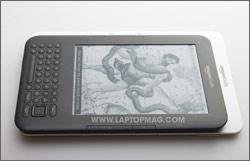
Click to enlarge
As with previous Kindles, users can read documents in a variety of formats, including PDF, Word .DOC/.DOCX, HTML, TXT and RTF. The device supports PDFs natively, but some other files (such as word processing documents) need conversion.
With previous Kindles, users would have to email the documents to their Kindle in order for them to be converted, but there was a fee attached (15 cents per megabyte) for the wireless delivery through 3G. For free conversion, users have to send the files to their @free.kindle.com address, wait until the file came though via e-mail, then sideload it. Now when you send files via @free.kindle.com, users can download documents to their Kindle at no charge when connected to Wi-Fi.
Notes and highlights now work in PDFs and other documents, but you won't be able to access them via the web, just the My Clippings file.
Ecosystem and Software
Though Amazon doesn't use an open format for their books, users are not constrained to the Kindle for reading. The company offers apps for iOS, Android and BlackBerry which work on both smart phones and tablets like the iPad or the upcoming Samsung Galaxy Tab and Blackberry PlayBook. There's also desktop software for both Mac and PC.
The newest versions of these apps and programs now also let you create, edit, and sync notes and highlights, which should appeal to students, but don't offer much else beyond reading. Users can't share notes to social networks or create or manage collections as these appear to be a Kindle-only features.
The newest versions of these apps and programs now also allow syncing and creating/editing for notes and highlights. This feature should be especially useful to students.
However, other than the basics of reading and adding notes, the apps and programs don't offer much else. Users can't share to social networks from the desktop software as they can from the Kindle itself. You also won't be able to create or manage collections from here, as this appears to be a Kindle-only feature.
Web Surfing
The new WebKit browser is an improvement over previous versions, but it still isn't an iPad-like experience. Users still have to hit Next Page to scroll down a page, which isn't intuitive. Still, multimedia-heavy sites such as NationalGeographic.com look mostly as they should; even the rotating feature art at the top refreshed on a regular basis and the complex style sheet rendered as a users would expect. We still wouldn't anticipate using this browser for anything but quick searches, but at least the experience is no longer as tedious.
Options and Accessories
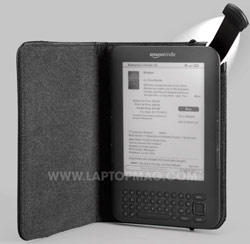
Click to enlarge
The Kindle 3G comes in two colors: white or graphite. Amazon also offers a lower-priced Kindle Wi-Fi ($139), which has the same features as the 3G but only comes with an 802.11b/g connection.
Amazon offers two new covers for this generation Kindle, a sturdy black leather case with an included light and a standard cover in burgundy. The light on the black cover is a thin, plastic affair that slides into the case when not in use and only turns on when you extend it fully. Another clever addition: The light uses the Kindle for power and it will only turn on if the Kindle is awake, not when it's in sleep mode. The case definitely feels like it could protect the Kindle but weighs 8 ounces by itself--almost as much as the eReader.
Battery Life
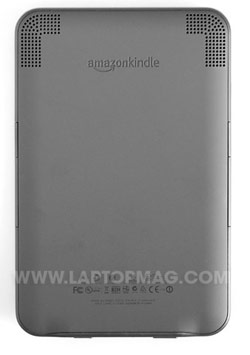
Click to enlarge
Amazon claims that the Kindle 3G will run for a month on a single charge with wireless off and up to 10 days with wireless on. In our usage, we noted that the battery didn't even get down to half when using it over 4 days with wireless on. And when wireless was off the battery meter barely budged over 2 days.
Verdict
The $189 Kindle 3G is an improvement over the already great Kindle 2. The combination of speed, good ergonomics, an improved display, and social sharing features all work in this eReader's favor. And the addition of Wi-Fi sweetens the pot. We don't like all of the design changes Amazon made, but overall we approve of the thinner, lighter unit. We wish the platform was more open like Barnes & Noble's Nook, which is only $10 more ($199 for 3G + Wi-Fi, $149 for Wi-Fi only), or the Kobo from Borders ($139 for Wi-Fi only). Still, Amazon's offerings are pretty robust, and the Kindle 3G offers one of the best hardware options on the market.
Wireless and Whispernet
The Kindle 3G still offers 3G connectivity through AT&T--a.k.a. Whispernet--but now includes 802.11b/g Wi-Fi and free access to AT&T hotspots around the country. As with the Kindle 2, Whispernet works globally, so users can still download content even if they're travelling abroad. By default, the device uses its 3G connection, but once users connect to a wireless hotspot, the Kindle will automatically switch whenever it's in range.
In our wireless tests, the Kindle 3G proved faster than the Kindle 2. Downloading The Hundred Thousand Kingdoms (a 545KB file) took 16 seconds, the Federations anthology (717KB) took 15 seconds, and How To Ditch Your Fairy by Justine Larbalestier (443KB) took 10 seconds. Overall, the Kindle 3G averaged a speed of 336.8 kbps over Whispernet. That's twice as fast as the Kindle 2 (120 Kbps) and quicker than the Sony Daily Edition (176 Kbps), but not as fast as the iRex DR800SG (629.6 Kbps).
With the Wi-Fi on, we were able to download a copy of the King James Bible (4,491KB) in 7 seconds, Jane Austen's Persuasion (315KB) in 2 seconds, and Warchild by Karin Lowachee (644KB) in 3 seconds, for an average of 2,703.2 kbps. This is faster than the Alex eReader (914.6) and the Pandigital Novel (1,744.2 kbps).
Users can manage the Kindle 3G remotely by logging into their account at Amazon.com. Here you can add subscriptions, resend books to your device(s), and access notes and highlights via kindle.amazon.com. Whispersync automatically synchronizes books, bookmarks, notes, and the last page read between your Kindle(s) and phone/tablet apps.
Content
There are more than 700,000 books available for the Kindle 3G, including more than 90 percent of The New York Times bestsellers. Unlike most other new eReaders, the Kindle 3G can't read ePub files. Users are mostly limited to the books in Amazon's (admittedly large) catalog with the exception of a few eBook stores that sell non-DRM .mobi files. This means owners can't shop around for the best price on most popular book titles. And if you ever decide to move on to a different eReader device, the books you purchase from Amazon won't port over.
Though the Kindle 3G's screen is not as large as its sister device the DX, reading magazine content was still pleasurable. Currently, 65 magazines and 134 newspapers are available; you can purchase single issues or pay for a subscription. If you purchase a subscription, new editions are sent automatically overnight or whenever you activate Whispernet, and you have 14 days to cancel.
Blog subscriptions start at 99 cents, and there are currently over 9,600 blogs to choose from. That's cheap, but free is better, so you may want to take advantage of the Kindle's web browser, which is now Webkit-based and much improved from the previous version.
Search, Notes, and Sharing
Finding definitions and searching within a book's text, user notes, or via Google and Wikipedia is fairly easy thanks to the full keyboard and D-pad. Moving the cursor around automatically brings up short definitions on each word you land on, and fuller definitions plus search options are available in just one or two clicks.
Making highlights and notes is equally simple and users also have the option to save and share these to Twitter and Facebook. The note's contents become the text of the status update and Amazon includes a link to the book as well. However, if you share your note, you'll have to keep it to 100 characters to fit into Twitter (minus the characters needed for the URL and hashtag). Highlighted passages have no character limit, as the status update will include a link to a page on kindle.amazon.com for your friends.
Amazon doesn't offer a simple way to export notes from a single book, but users can access all notes and highlights via the My Clippings file on the Kindle as well as online and via apps. We wish Amazon offered a way to parse the information in this text file and group all notes from one book together instead of having them in chronological order. Still, the ability to Clip and save a whole magazine article is appealing, especially when doing research.
Amazon's latest refresh of its popular Kindle eBook reader is leaner, meaner, and now less than $200. For just $189, the Kindle 3G offers improved battery life, display technology, and can connect over Wi-Fi as well as 3G. In almost every way, the Kindle 3G is an improvement over the previous generation, with a few minor exceptions. Regardless, bookworms will find the Kindle 3G to be one of the best eReaders on the market.
Design
Aside from the graphite paint job, Amazon also brought some significant design changes in the Kindle 3G. Overall, this new generation is thinner and lighter and has a smaller footprint. At just 7.5 x 4.8 x 0.34 inches and 8.7 ounces (compared to 8.0 x 5.3 x 0.36 inches and 10.2 ounces for the previous model ), it's almost as small and light as the Kobo Reader. The Kindle shares one other similarity to the Kobo: The back of the device, which used to be metallic, now has a soft-touch coating.
In making the unit thinner, it looks like Amazon had to shuffle some internal components around. Now the On/Sleep/Off slider is on the bottom--less convenient, but only a minor annoyance--along with the microUSB port, headphone jack, and volume toggle. The buttons on the sides and lower portion of the device's face are more streamlined and, in some cases, smaller.
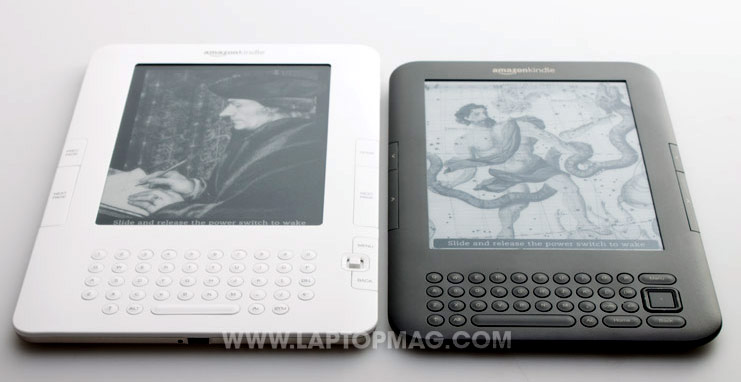
Click to enlarge
The page turn buttons are one of the more obvious changes, being only 0.16 inches thick instead of the 0.4-inch thickness on the Kindle 2. We had feared that the narrower buttons would affect ease of use, but all four are easy to press, yet firm, making for good feedback and a sturdy feel. There are now both Next and Previous Page buttons on both sides, so both left and right-handed readers can use their dominant hand. Plus, the Next Page buttons remain the same length as before, allowing users to rest their thumbs comfortably on them no matter what size hand they have. We had no trouble keeping our thumb in place and our eyes on the display as we read.
The joystick of Kindles past has been replaced with a directional pad that sits next to the keyboard instead of under the page turn buttons on the right side. We're not fans of this change, as the arrow keys here are very narrow, and occasionally caused us to accidentally hit the Menu and Back buttons, which have moved down to the keyboard area along with Home.
The keyboard remains usable, but we're not sure why Amazon got rid of the number row. To access numbers, users have to press the SYM button, then use the D-pad to select. When entering Wi-Fi passwords or location numbers in books, this quickly becomestedious.
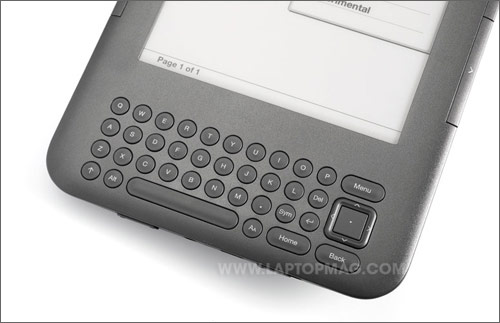
Click to enlarge
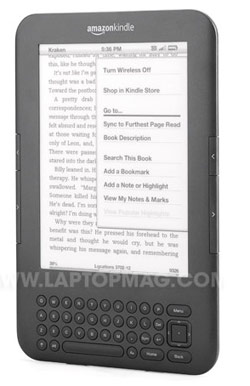
Click to enlarge
Display and Reading Experience
Amazon claims that the e-Ink screen on the Kindle 3G has 50 percent more contrast than the previous generation. Comparing the two side by side, text on the 3G is darker, which makes reading easier. Images benefit from this improvement as well: The cover for N. K. Jemisin's "The Hundred Thousand Kingdoms" is crisper on the 3G, and slightly more detail is visible. The greater contrast also makes reading outdoors easier and more pleasurable.
Users have more control over how the text looks on screen. As before, there are eight font sizes to choose from, but now you can also choose between three typefaces: regular, condensed, and sans serif. Users can also fit more text on a page by shortening the space between words, as well as condensing the amount of space between the lines. We would have appreciated an option that allowed us to increase the space at least one notch as well. There's no built-in accelerometer as with the Kindle DX, but you can manually change the screen orientation in all four directions.
Page turns on the 3G are a hair faster than the Kindle 2, coming in at just under a second.
Amazon Kindle 3G Specs
| 3G | AT&T |
| Audio Formats | MP3, Audible (AA, AAX) |
| Company Website | http://www.amazon.com |
| Compatability | PC, Mac |
| Document Formats | RTF, PDF, DOCX, TXT |
| Electronic Paper Display Resolution | 600 x 800 |
| Electronic Paper Display Size | 6 Inches |
| Headphone Jack | 3.5mm |
| Image Formats | PNG, JPEG, GIF, BMP |
| Internal Memory | 4GB |
| Operating System | Amazon |
| Rated Battery Life | 10 days (wireless on)/ 1 month (wireless off) |
| Size | 7.5 x 4.8 x 0.34 inches |
| Warranty/Support | 1-year limited warranty and service |
| Weight | 8.7 ounces |
| Wi-Fi | 802.11b/g |
| eBook Formats | AZW, MOBI, HTML |
